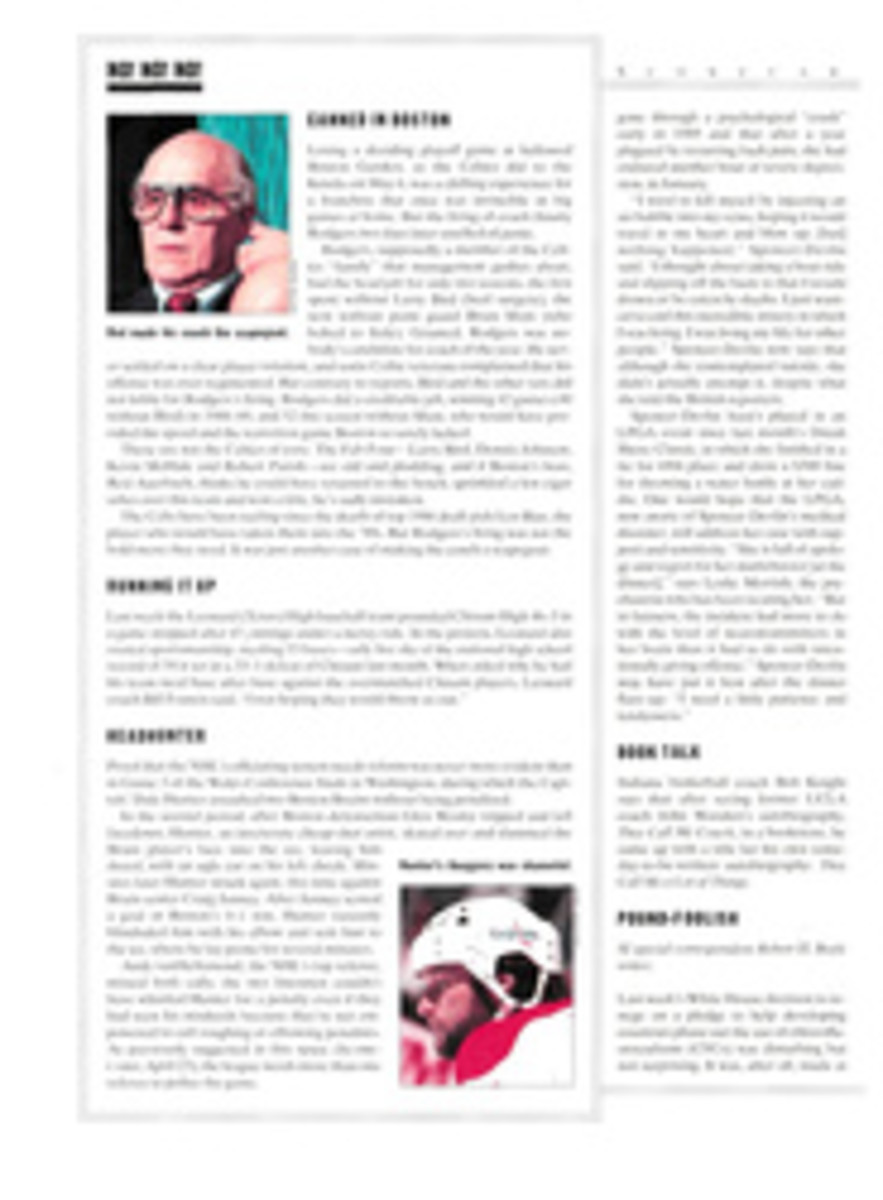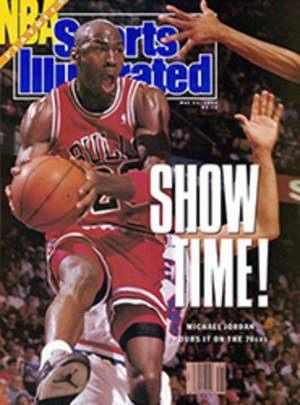
HANDS ON
He played sometimes at night this year on a frozen inlet of the Charles River in suburban Auburndale, Mass., called the Cove. No pads. Just a hockey stick. Just a pair of hockey gloves. Just a pair of skates. Weren't the Boston Bruins, his team, supposed to be playing a game a dozen or so miles downriver at the Garden? No, that had to be some other night. Craig Janney was back on natural ice. Just for fun.
He would skate with friends and strangers under the lights there. Pickup hockey. Pond hockey. There would be no blue lines, no red lines, no boards and no buzz of attention. This was the best. He would go where he wanted to go and do what he wanted to do. The puck was his.
"You are the best right wing I ever played with," he would shout to Mike Mullowney.
"Better than Cam Neely?" Mullowney would ask.
"Better."
Mullowney is 50 years old and a stockbroker and the father of one of Janney's friends. Mullowney would skate to a position somewhere to the side of the goalie and put his stick on the ice and wait. Janney would move past one player, cut around another, surprise a third. The puck would never leave his stick. It was attached to the stick by some mysterious force that traveled through the blade and up the shaft and through the gloves to...to his hands. How about those hands? Control, control, control. His hands would control the game. His hands would control the night. Janney would make a pass at last. Mullowney would simply move his stick.
Who couldn't score the goal?
"The best right wing I ever played with," Janney would shout.
"Better than Cam Neely?"
"Better."
The rest of the players would look with out-of-breath wonder. How does he do that? If asked, he would say that he did not know.
"You know what happens when you're on the ice and Craig Janney is on your side and has the puck?" Derek Sanderson, the former Bruin and now a television broadcaster, asks. "You're always eligible! You know what that means? There's always a way he can get the puck to you. Keep working. Keep moving. He'll get it there one way or another. Most guys, there's a second when they can make the play...Craig Janney? Keep moving. You're always eligible."
The stage has moved to the finals of the Stanley Cup, the Bruins against the Edmonton Oilers, but the basic question is the same. How does he do that? The hands are the same, and the results, often as not, are the same. The pond somehow still belongs to this slender 22-year-old center from Enfield, Conn., and Boston College, this quiet young guy with the velvet touch.
Each stop on the Bruins' happy march to the finals brought another play to be remembered. Another goal. Another pass. Another...wait a minute, what's he doing? Control, control, control. He has picked up three goals and a 1990 playoff-high 19 assists in 13 games. Against the Hartford Whalers, he scored the game-winning goal in the seventh game. Against the Montreal Canadiens, he set up the game-winner in overtime in the pivotal second game. Against the Washington Capitals, in the third game, he scored the game-winner and was knocked dizzy on the same play. He has passed the puck between people's skates, around falling bodies and over the corner of the net from in back of the goal. He has helped Neely, his right wing and an NHL All-Star, score 12 goals after scoring 55 in the regular season. He has made an elephant and a brass band appear from a top hat.
A local columnist has requested that his hands be insured by Lloyd's of London. A hockey writer has compared him to Madge in those Palmolive dish-soap commercials. The hockey term "soft hands" has been mentioned again and again. These are hands that somehow can control the stick that controls the puck, hands that would work nimbly at second base in the middle of a double play, hands that a neurosurgeon would slide into rubber gloves. A teammate, Dave Poulin, suggests that Janney must have learned how to stick-handle in a shoebox.
"Here's what amazes me," Bruins coach Mike Milbury says. "Everybody's looking for him, and he's still successful. What's the first thing you're going to stop if you play against us? Janney passing to Neely. That's what you work on doing. That's your plan. And yet Janney's made that pass 50 or 60 times this year and Neely's scored the goals. That's what is most amazing."
"What's the comment everyone makes when he comes into this league?" teammate Andy Brickley says. "He says, 'The big difference is the speed of the game. It's faster.' Well, here's a guy who isn't bothered by that speed. He has such a low panic button. He just holds on to the puck while everybody else is looking to get rid of it."
The comparison that has been made most often is to a certain center for the Los Angeles Kings. There has been an immediate disclaimer that nobody is Wayne Gretzky, that it is the heresy of heresies even to mention anyone else's name with Gretzky's, and yet...and yet, there are certain moves. The ability to wait and wait, to refuse to surrender the puck, is a legitimate comparison. Doesn't Gretzky wait until other people commit, then move past as they lose their momentum or balance? The ability to work from behind the opponent's net is another comparison. Isn't Gretzky a master at working from behind the opponent's net? Doesn't Janney do the same thing, turning the game upside down, making nearly impossible passes from behind the goalie's back?
It would be easy to suggest that this is the first in a line of kids who have grown up with an image of the Gretzky game in their minds. It would be easy, but it would be wrong.
"I saw Gretzky play on television, of course, but I never really watched sports too much," Janney says. "I mostly just went out to play. I wasn't playing hockey to be in the National Hockey League. I basically wanted to play to make some friends and have some fun. I played baseball. I played soccer. I just played whatever sport was in season. I wasn't one of those year-round hockey players. I think that's awful, playing only one sport all year when you're a kid."
Few if any players from Connecticut have made the NHL. How could Janney even think about the NHL? There wasn't even a rink in his hometown of Enfield until his mother and father joined some other parents in raising funds to build one. Hockey was a pastime, not a career opportunity in Enfield, a town at the top of the state, as far away in character from the New York commuter rush of suburban Fairfield County as a town in the middle of Indiana might be.
"My older brother, Matt, played," Janney says. "He was another center. He was five years older than me, so I never really got to play on the same team with him until two years ago, when I played a game with his team in a summer league. Set him up for a goal. Then his team had to forfeit the game because the other team found out who I was. It broke some kind of long winning streak, too. My sister even played for a while. A defenseman. The big D. She had a wicked slap shot."
There were no special drills that he remembers. There was no special advice. Janney's ideas about hockey simply evolved. How do you teach stickhandling and control? How do you make hard hands soft? They are a gift. He had the gift. He was stickhandling through the rest of the crowd almost as soon as he started playing. The puck belonged to him from the beginning.
"He was just one of those kids who always was playing with the older kids," his mother, Monica, says. "He was good enough."
He was drafted by the Bruins in the first round (13th pick overall) in 1986, after his freshman year at Boston College. The Bruins felt their choice was either Janney or forward Adam Graves of Windsor in the Ontario Hockey League, who is now with the Oilers. They felt that Graves would be a constant, a given, a solid NHL player. Janney, they felt, would be a gamble. There was a chance he could be great. There was another chance he would not be fast enough even to make the NHL. They decided to take the gamble.
He played a second season at BC, then joined the 1988 U.S. Olympic team. At the completion of the Olympics, he joined the Bruins at the tag end of their season. He lived at Mullowney's house, uncertain about what would happen next. He never left. The Bruins went all the way to the Cup finals. Janney wound up centering the top offensive line, teaming with Neely for the first time, a combination that immediately worked.
"It's funny," Janney says. "Wherever I go, I usually find someone who works well with me. Cam and I just think alike, I guess. I know exactly where he's going to be. He knows I'm going to get the puck to him. I just put it out there, and he takes care of the important stuff. That's why he makes the big money."
Milbury would like Janney to shoot more. Of the 62 points he scored in 55 regular-season games, only 24 came on goals. ("I know I should look to shoot more," Janney says, "but I find myself just working on reflex, and my reflex is to pass.") Milbury also would like Janney, who is 6'1" and 190 pounds, to work more in the off-season on weights and a conditioning program. ("He has soft hands," the coach says, "and he also has a soft midsection.") Janney would mostly just like to play.
He is made nervous by the sudden attention. Soft hands? What soft hands? He struggles with explanations. How do you explain instinct? Hockey is free-form dance, not cumbersome words. Hockey is innovation, figuring out geometric angles on the move, angles that always change. Hockey is dangling the puck. His term. Dangling. The big ponds simply are variations on the small ponds. There is more noise, but the game is the same.
"I think I'll always play hockey," he says. "It's just fun for me to play."
An image forms: Years pass and Cups are won or lost and retirement dinners are held. A station wagon appears at the Cove. A gray-haired guy steps but, ties on some skates, carries a stick onto the ice and takes control of the puck. Skates through everyone. Dangling. Kids run at him. More kids run at him. No one can take the puck away. How does he do that? Who is this guy?
"That's me," Janney says. "I'll be Mr. Mullowney."
Better than Cam Neely.
PHOTO
JERRY WACHTER
Not unlike the Great One, Janney excels at making deft plays from behind the enemy net.
PHOTO
JOHN ABBOTT
[See caption above.]
TWO PHOTOS
JERRY WACHTER
Janney went airborne when checked by the Caps' Scott Stevens in Game 4, and a subsequent hit brought forth the trainer.
PHOTO
JERRY WACHTER
A Neely goal drew cheers from Janney and Brian Propp (36).

